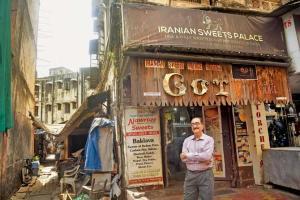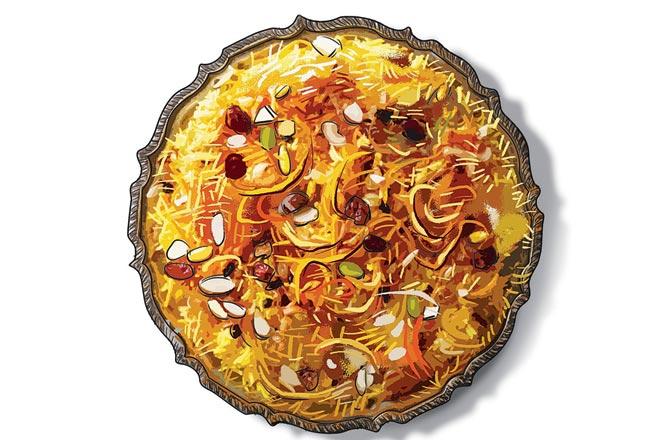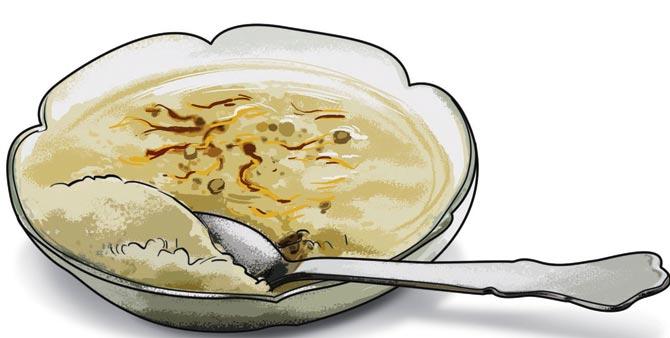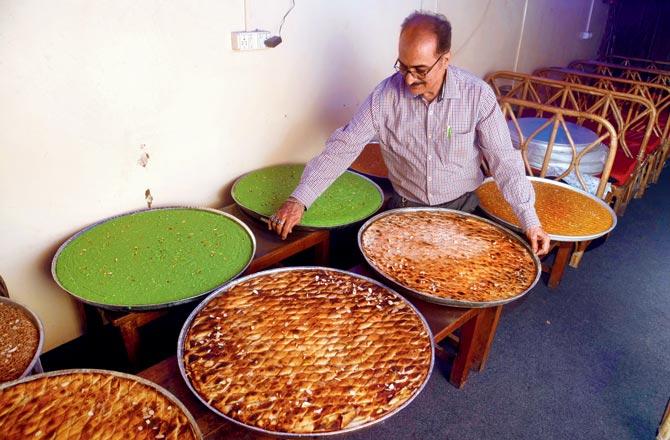An ancient celebration attached to the Northern Hemisphere's vernal equinox plays out in Mumbai each year by the Parsi and Iranian Zoroastrian community. Before you sign up for that hoax Navroze lunch spread at a suburban resto-bar, read this

Hassan Hajati has kept the tradition of Nowruz sweets alive in a city where the Iranian population is fast dwindling. Pics/Atul Kamble
My brother and I are more Parsi than Iranian, despite mixed but equal genes. But for one day every year, we'd switch gears, renewing our ties with the country our father left as a teenager to make a life in Mumbai. Our mother, a Parsi, was debilitated by language although high on enthusiasm. She gave up, I estimate, on Persian when she confused cherries ("gilas" in Farsi) with the English "glass", ending any hope of earning brownie points from her mother-in-law. She'd stand awkwardly but amiably as my father greeted guests around the sofreh, spraying them with rose water, and showing them their reflection in a table mirror—a way to reflect on the year gone by. A bite of baklava or a mouthful of walnut and ghesei (apricot) were followed by the double hug.
ADVERTISEMENT
Nowruz ("new day") was centred at home around the sofreh, a table with an elaborate spread. It was a sort of thanksgiving punctum, stacked with everything that nature offers you, because the festival celebrates the onset of spring and the agricultural season after a long, trying winter. Although every home customises the "table" (ours veers towards dry fruit, wine, sweets and flowers), the spread must include seven items beginning with the Farsi letter for seen: Sabzeh (wheat or barley sprouts); sir (garlic); sib (apples); sumac (berries); serkeh (vinegar) samanu (wheat germ pudding) and senjed (dried fruit from lotus tree).

Nowruz (celebrated sometime between March 19 and 21) is the day of the vernal equinox and marks the beginning of spring in the Northern Hemisphere
Interestingly, the day has no religious significance. It's a universal celebration of new beginnings, of seasons, of light over dark, and is an opportunity to strengthen kinship. It speaks peace, reconciliation, solidarity with family and neighbours. The Iranian emperor Jamsheed Pishdadian (also called Jamshedi Nowruz after him), who is set to have sowed the seeds of the idea, might have looked at it as a tool to hold the community together, much like what Tilak did with Ganesh festival.
It's a tradition that's close to 3,000 years old, and has made it to the UNESCO List of Intangible Cultural Heritage of Humanity. It's estimated that almost 300 million people celebrate it worldwide, including the Afghans, the Baha'is, the Kerds. And, Mumbai's tiny bunch of Parsis and Iranians.
Recipes
Your Iranian dinner at home
After zereshk (berry) pulao hit headlines as Britannia & Co. Restaurant's top selling dish, several others have tried to pull it off, but I won't vouch for them. Either go to the original outpost at Ballad Estate, or better still, make a batch at home. In any case, Britannia has lost half its charm since the passing of its owner, the affable raconteur Boman Kohinoor.
The zereshk or barberries are grown in Iran's Khorasan province, and give this dish a tart flavour. My family gets batches from generous friends coming down from Tehran, sealed in containers to place in the fridge. But they are also occasionally available at Crawford Market's dry fruit shops, and of
course, online.
The borani-e-bademjan is fresh and herby—perfect to serve as finger food with lavash. And there cannot be a simpler dessert to make than sheer berenj, with the rose water scent giving it that Samarkand feel.
Zereshk Polow (Barberry rice)

Illustration/ Uday Mohite
Ingredients
1 kg chicken, curry pieces, skinned
3 cups long grain rice
2 onions, thinly sliced
1 cup barberries (zereshk)
1/2 tsp ground pepper
2 cloves garlic
Few strands of saffron, roasted on hot tava and added to a few tbsp hot water
2 tbsp butter
2 tbsp curd
4 tbsp sugar
2 tbsp jeera
1 tsp haldi
salt to taste
Method
Wash the chicken well and marinate it in haldi, salt and pepper powder. Soak barberries in warm water for 15 mins.
Take oil in a kadhai and fry garlic and onions till golden. Reduce heat and add barberries and sugar. Stir. Ensure, they don't burn. Add marinated chicken and saute on high heat for 5 mins so that the outsides brown slightly. Add water and bring to a boil. Turn down the flame, cover the kadhai and let the chicken cook till little gravy remains.
Take a small pan with 1 tsp of butter and fry a few barberries for garnishing. They'll turn plump and blood red. Set aside.
In a pot, boil 6 cups of water and add salt. Add washed rice to the water and let it boil for 10 minutes. Stir gently and occasionally. Lower heat, cover pot and let the rice cook till half done. When done, drain the water out in a large strainer. Rinse with cold water so that the rice grains are separate.
Take a bowl and whisk in the curd, 1 tbsp saffron water, 1 tbsp oil and a drizzle of water. Add 2 large ladles of rice and gently toss. Take this mixture and spread as bottom-most layer in a deep dish greased earlier with butter. This will form a crusty base.
Mix the remaining saffron water in the rest of the rice and gently toss to give it an even golden hue.
Above the first later in the dish, place a second layer of half cooked rice. Top this with a layer of chicken pieces and gravy. Pat it down to level but don't press too hard. Add the remaining rice to make the third layer. Add a fourth layer of the remaining chicken and gravy, and finally top it with a last layer of rice. Add a few blobs of butter to the top. Cover with lid, and place a heavy weight on top to ensure the steam doesn't escape. Reduce the heat and cook for 40 mins.
When cool, gently try and scoop out the rice to place at the centre of a serving dish, and the chicken pieces around it along the edges. Take some of the fried barberries and sprinkle on the rice. You can add an additional garnish of thinly slivered pista and almond (unsalted) if you like.
To those who like a bit of crunch, serve the bottom crust directly on their plate.
Make it vegetarian by replacing the chicken with potatoes and any veggies of your choice.
Sheer Berenj (Rose Water Kheer)

Illustration/ Uday Mohite
Ingredients
1/2 cup short grain rice
1/4 tsp salt
2 cups water
3 cups milk
1/2 cup cream
1/4 cup rose water
1tsp cardamom powder
Method
Clean and wash the rice. Place it in a pan with water and 1/4 tsp salt. Bring to boil and lower flame. Cover with lid and cook on low flame for 15 mins until rice is cooked. Add the milk and cream. bring the mixture to a boil before reducing flame. Cover and cook for 25 mins or until the mixture has become thick.
Add the rose water and cardamom and cook for another 5 mins on very low flame.
Remove from heat, and portion it into individuals serving bowls. Cool in the refrigerator for 1 hour. Serve topped with slivered nuts and raisins.
Borani-e-bademjan (Brinjal and Curd Relish)

Illustration/ Uday Mohite
Ingredients
2 large brinjals
A few cloves garlic, peeled and crushed
1 tbsp olive oil
1 tsp salt
1/2 tsp pepper powder
1 large cup curd that's been placed in a muslin cloth and hung to drain out the whey
1 tbsp fresh lime juice
2 tbsp chopped mint leaves
1/4 tsp saffron threads (heat on hot tava, crush between fingers, add to 1 tbsp warm water and set aside)
Method
Wash and wipe the brinjals. Place them one by one on a high flame to grill, turning the sides to ensure they are evenly grilled (like you'd do for baingan bharta). When soft and seared, take them off the flame and allow to cool down.
Scrape off the skin, discard the stem, and mash the flesh in a bowl. Add the remaining ingredients one by one and mix as you go along. Adjust seasoning.
Empty into a serving bowl and garnish with saffron water and mint leaves. Chill for a bit in the fridge before serving but never ice cold. Serve with bread sticks, lavash or crackers.
Eating out
Last man standing: Hassan Hajati

Hajati uses dry fruit and honey from Iran in his louz and baklava
Because eateries that have little to do with authentic Parsi cuisine, let alone, Persian, attempt to curate menus befitting Navroze each year, here's clearing the air once and for all
Born to a Parsi-Iranian pair, I have long been the de facto advocate of mixed heritage, spending much time explaining to friends the difference between a Parsi and Irani.
The answer to that question is this: Zoroastrians (followers of Prophet Zoroaster) comprise two groups. The Parsis are descendants of those who sought refuge from the Arab invasion of Iran in the 7th century and sailed on a boat to secure shores, landing in Sanjan, Gujarat. Hundreds of years in India means they are now more Indian than the rest; their dress (Parsi brides wear a saree to their wedding), food (ambakaliyu is a squishy mango chutney without which no khushaali no gahambhar or celebratory public feast is complete), culture (chalk designs made outside their homes with calcium carbonate powder falling through patterned sieves of tin, inspired by the rangoli) and language (they speak a hybrid version of Gujarati), influenced significantly.
The second group, Iranian Zoroastrians, stayed back in Iran after the conquest. Later, in the 19th century, some of them inspired by how well the Parsis had done in India, decided to follow for professional opportunities. Most of them were absorbed into the restaurant business, giving Mumbai its iconic culinary institution, the Irani café. Recent migrants, this lot essentially speaks Persian, and continues to have strong culinary and cultural ties with Iran. You don't expect to be served dhansak-vagharela chawal at a Mumbai Irani's home. It's aabgoosht (lamb, vegetable and chickpea soup) or khoresh-e-qormeh sabzi (fresh herb stew) that's staple.
Interestingly, at the cafés, the Iranis served everything but Persian eats. It's possibly because they were clear that they were migrants, catering to the working class in India, whose culture and food habits were moons away from their own. So, it wasn't jujeh kabab (skewered chicken) they stirred up in the kitchens but kheema pao and akoori (piquant Parsi version of the anda bhurji).

Zaffran louz
While the city continues to be dotted by eateries that serve Parsi dishes, both true-to-original and imposter adaptations, it's tough to find an establishment that will serve you Iranian fare.
Colaba's Piccadilly, which shuttered last year, made a competent chelow kabab (meet and rice) and torshi (pickled vegetables in brine). Fort's Cafe Universal, run by the Dehmiri family, has stray items including the ghemeh bademjan (minced chicken and brinjal), that speak of an original taste.
Cafe Universal, Fort, Monday to Saturday, 9.30 am to 11 pm
While a full Iranian meal might elude you in the city, what doesn't is dessert. At Hassan Hajati's halviyat (sweets shop), the worn out sign board speaks of its vintage. The modest store on Dongri's Imamwada Road completes 111 years this year; owner Hajati having become the sole flag bearer of the Persian sweet tradition. Like his brethren, Hajati's tryst with India goes back to the early 1900s when his grandfather migrated. Buying this shop for a two-figure sum, he established his hold in an area thronged by Muslim and Zoroastrian Iranians.
Hajati sets aside his stock market business for one month of the year, to focus solely on burning the wood in his old-world kitchen pits all through March. If you crave his fare any other time, he would need to do a rain check for advance bulk orders. While fancy Middle Eastern sweets parlours will offer you the flimsy filo baklava, for a diamond-shaped dense brick with Iranian dry fruits and cardamom kick, come here. Low wooden benches balance massive aluminium thaals that carry a small but unique variety of louz (la-ooz) in pista, badam and zaffran (saffron) flavours. All of it goes in by the kilo into kitschy, floral cardboard boxes to make its way to homes where it will symbolise "shirin" (sweet) at the sofreh or Nowruz table spread.
Iranian Sweets Palace, Monday to Saturday, 11 am to 7.30 pm (timings only for March)
Catch up on all the latest Mumbai news, crime news, current affairs, and also a complete guide on Mumbai from food to things to do and events across the city here. Also download the new mid-day Android and iOS apps to get latest updates
 Subscribe today by clicking the link and stay updated with the latest news!" Click here!
Subscribe today by clicking the link and stay updated with the latest news!" Click here!







